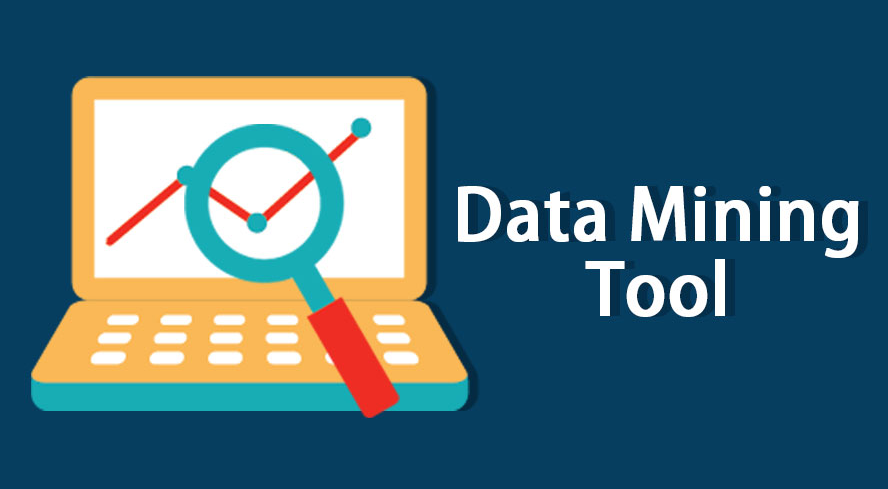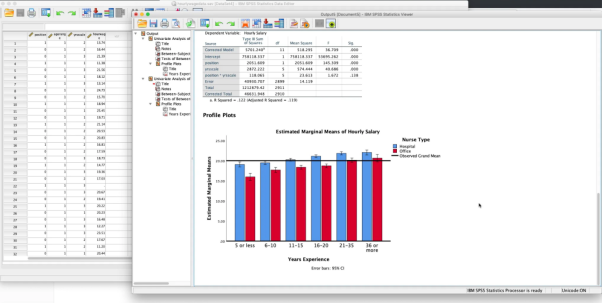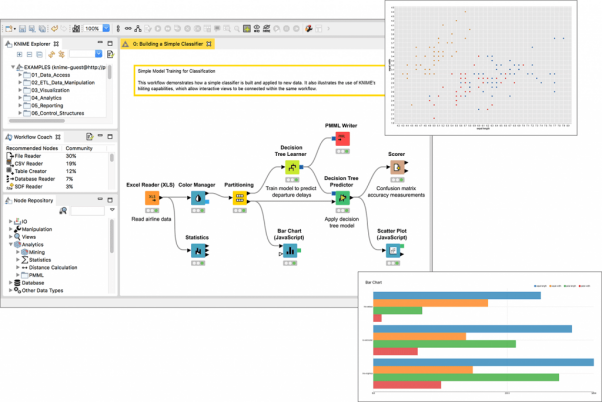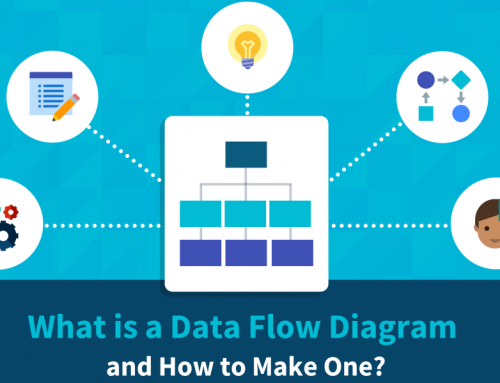21 Best Data Mining Tools and Software 2022
Data mining is the process of extracting practical information from data, interpreting data, discovering data patterns and relationships, and predicting trends and behaviors through intelligent methods. This process often involves data cleaning, machine learning, artificial intelligence, data analysis, database systems, and statistical techniques such as regression and clustering. Obviously, the larger and more complex the data set, the easier it is to find the more relevant meanings quickly and easily through automated analysis tools. By identifying and understanding meaningful data, businesses can make informed decisions and achieve their goals. In this article, we’ll introduce 21 best data mining tools and software in 2022.

Best Data Mining Tools
Before diving into our article, let’s figure out the basic steps of data mining.
We can apply data mining to various scenarios such as market segmentation, trend analysis, fraud detection, database marketing, credit risk management, education, and financial analysis. Although the methods used by each organization may vary, in general, the data mining process generally consists of the following five steps:
- Identify business needs based on established goals.
- Identify data sources to determine which data points need to be analyzed.
- Select and apply modeling techniques.
- Evaluate the model to ensure it meets the stated goals.
- Report the results of data mining, or continue with a repeatable data mining process.
Integrated Data Mining Tools for Statistical Analysis
Best Data Mining Tools – 1.IBM SPSS
SPSS(Statistical Package for the Social Sciences) is one of the most popular statistical software platforms at present. Since it began to provide statistical products and service solutions in 2015, various advanced capabilities of the software have been widely used in learning algorithms, statistical analysis (including descriptive regression, clustering, etc.), text analysis, and integration with big data, etc. At the same time, SPPS allows users to improve their SPSS syntax by using Python and R with various professional extensions.

Best Data Mining Tools
Best Data Mining Tools – 2.R
R is a programming language that can be used in statistical computing and graphics environments. It is compatible with UNIX, FreeBSD, Linux, macOS and Windows operating systems. R can be used in various statistical analysis scenarios such as time series analysis, clustering, and linear and nonlinear modeling. At the same time, as a free statistical computing environment, it can also provide a coherent system, various excellent data mining packages, graphical tools for data analysis, and a large number of middleware tools. In addition, it is an open source solution for statistical software such as SAS and IBM SPSS.
Best Data Mining Tools – 3.SAS
SAS (Statistical Analysis System) is a suitable choice for data and text mining (tex mining) and optimization. It is able to provide a variety of analytical techniques and methodological capabilities according to the needs and goals of the organization. Currently, it is able to provide descriptive modeling (helps in classifying and describing customers), predictive modeling (facilitates prediction of unknown outcomes), and analytical modeling (for parsing, filtering and transforming fields such as email, comments) , books and other unstructured data). In addition, its distributed memory processing architecture is highly scalable.
Best Data Mining Tools – 4.Oracle Data Mining
Oracle Data Mining (ODB) is part of Oracle Advanced Analytics. This data mining tool provides excellent data prediction algorithms for classification, regression, clustering, association, attribute importance judgment, and other professional analysis. In addition, ODB can also use interfaces such as SQL, PL/SQL, R and Java to retrieve valuable data insights and make accurate predictions.
Open Source Data Mining Tools
Best Data Mining Tools – 5.KNIME
KNIME(Konstanz Information Miner), an open source software first published in 2006, is now widely used in data science and machine learning in banking, life science, publishing and consulting industries. At the same time, it provides local and cloud connectors to enable data migration between different environments. Although it is implemented in Java, KNIME provides various nodes to make it easy for users to run it in Ruby, Python and R.

Best Data Mining Tools
Best Data Mining Tools – 6.RapidMiner
As an open source data mining tool, RapidMiner integrates seamlessly with R and Python. It creates new data mining processes by providing rich products and provides various advanced analytics. At the same time, RapidMiner is written in Java and can be integrated with WEKA and R-tool. It is one of the most useful predictive analysis systems. It provides useful features such as: remote analytical processing, creation and validation of predictive models, multiple data management methods, built-in templates, repeatable workflows, data filtering, and merging and joining.
Best Data Mining Tools – 7.Orange
Orange is an open source data mining software based on Python. Of course, in addition to providing basic data mining capabilities, Orange also supports machine learning algorithms that can be used in data modeling, regression, clustering, preprocessing, and more. Orange also offers a visual programming environment and the ability to easily drag and drop components and links.
Big Data Data Mining Tools
Conceptually, big data can be either structured, unstructured, or semi-structured. It usually covers the five V characteristics, namely: volume (volume, which may reach terabyte or petabyte level), variety (variety), velocity (velocity), accuracy (veracity) and value (value). Given its complexity, it is difficult for us to process and implement massive data storage, pattern discovery, and trend prediction on one computer, so distributed data mining tools are needed.
Best Data Mining Tools – 8.Apache Spark
Apache Spark is popular for its ease of use and high performance for processing big data. It has multiple interfaces for Java, Python (PySpark), R (SparkR), SQL, Scala, etc., and can provide more than 80 advanced operators to facilitate users to write code faster. In addition, Apache Spark also provides code libraries for SQL and DataFrames, Spark Streaming, GrpahX and MLlib for a fast data processing and data streaming platform.
Best Data Mining Tools – 9.Hadoop MapReduce
Hadoop is a collection of open source tools for handling large amounts of data and various computing problems. Although written in Java, any programming language can be used with Hadoop Streaming. Among them, MapReduce is the implementation and programming model of Hadoop. It allows users to “map” and “reduce” various commonly used functions, and to perform large join operations across huge datasets. In addition, Hadoop also provides applications such as: user activity analysis, unstructured data processing, log analysis, and text mining. At present, it has become a widely applicable scheme for performing complex data mining on big data.
Best Data Mining Tools – 10.Qlik
Qlik is a platform for data analysis and mining in a scalable and flexible way. It features an easy-to-use drag-and-drop interface and responds instantly to user modifications and interactions. To support multiple data sources, Qlik enables seamless integration with various external application formats through a variety of connectors, extensions, built-in applications, and API sets. At the same time, it is also a great tool for centralized shared analytics.
Small Data Mining Scheme
Best Data Mining Tools – 11.Scikit-learn
As a free software tool for Python machine learning, Scikit-learn provides excellent data analysis and mining capabilities. It has functions such as classification, regression, clustering, preprocessing, model selection, and dimensionality reduction.
Best Data Mining Tools – 12.Rattle (R)
Rattle, developed by the R language, is compatible with operating systems such as macOS, Windows and Linux. It is primarily used by users in the US and Australia for corporate business and academic purposes. The computing power of R can provide users with functions such as clustering, data visualization, modeling, and other statistical analysis.
Best Data Mining Tools – 13.Pandas (Python)
Pandas is also a “good guy” for data mining with Python. The code base provided by it can be used to perform data analysis and manage the data structure of the target system.
Best Data Mining Tools – 14.H3O
As an open source data mining software, H3O can be used to analyze the data stored in the cloud architecture. Although written in R, the tool is not only compatible with Python, but can also be used to build various models. In addition, thanks to the language support of Java, H3O can be quickly and easily deployed into production environments.
Solutions for Cloud Data Mining
By implementing cloud data mining technology, users can retrieve important information from a virtual integrated data warehouse, thereby reducing storage and infrastructure costs.
Best Data Mining Tools – 15.Amazon EMR
As a cloud solution for processing big data, Amazon EMR can not only be used for data mining, but also perform data science tasks such as: web indexing, log file analysis, financial analysis, machine learning, etc. The platform offers a variety of open source solutions including Apache Spark and Apache Flink, and can improve the scalability of big data environments by automatically tuning tasks such as clusters.
Best Data Mining Tools – 16.Azure ML
As a cloud service-based environment, Azure ML can be used to build, train and deploy various machine learning models. For various data analysis, mining and prediction tasks, Azure ML allows users to calculate and manipulate data of different volumes in the cloud platform.
Best Data Mining Tools – 17.Google AI Platform
Similar to Amazon EMR and Azure ML, the cloud-based Google AI Platform is also able to provide various machine learning stacks. Google AI Platform includes various databases, machine learning libraries, and other tools. Users can use them in the cloud to perform data mining and other data science-like tasks.
Data Mining Tools Using Neural Networks
Neural networks process data essentially the way the human brain processes information. In other words, because our brains have millions of neurons that process external information and produce output, neural networks can follow this principle to achieve data mining by converting raw data into relevant information.
Best Data Mining Tools – 18.PyTorch
Pytorch is both a Python package and a deep learning framework based on the Torch library. It was originally developed by Facebook’s AI Research Lab (FAIR) as a deep neural network-like data science tool. The user can program the entire neural network through Pytorch by: loading the data, preprocessing the data, defining the model, performing training and evaluation, and such data mining steps. In addition, with the powerful GPU acceleration capability, Torch can achieve fast array computation. As of September 2020, torch’s R ecosystem includes torch, torchvision, torchaudio, and other extensions.
Best Data Mining Tools – 19. TensorFlow
Similar to PyTorch, TensorFlow, developed by the Google Brain Team, is also an open-source machine learning framework based on Python. It can be used both to build deep learning models and to be highly focused on deep neural networks. The TensorFlow ecosystem not only provides the flexibility to provide a variety of libraries and tools, but also has a wide and popular community where developers can conduct various Q&A and knowledge sharing. Despite being a Python library, TensorFlow started introducing an R interface to the TensorFlow API in 2017.
Data Mining Tools for Data Visualization
Data visualization is the graphical representation of the information extracted from the data mining process. Such tools allow users to visualize trends, patterns, and outliers in data through graphs, charts, maps, and other visualization elements.
Best Data Mining Tools – 20.Matplotlib
Matplotlib is a great tool library for data visualization with Python. It allows users to create quality charts such as histograms, scatter plots, 3D plots, etc. using interactive graphics. And these charts can be customized in terms of styles, axis properties, fonts, and more.
Best Data Mining Tools – 21.ggplot2
ggplot2 is also a popular R toolkit for data visualization. It allows users to build a variety of high-quality and beautiful graphics. At the same time, users can also use this tool to modify various components in the diagram with a high degree of abstraction.
Conclusion
As mentioned earlier, most data mining tools or solutions use the two main programming languages R and Python, as well as various corresponding packages and libraries. For developers or data scientists engaged in data mining, it is very necessary to learn and understand various types of data analysis and mining tools. Of course, how to choose the right tool depends on your current business or research goals.
If you want to learn more about data mining, we would like to advise you to visit Gudu SQLFlow for more information. As one of the best data lineage tools available on the market today, Gudu SQLFlow can not only analyze SQL script files, obtain data lineage, and perform visual display, but also allow users to provide data lineage in CSV format and perform visual display. (Published by Ryan on Sep 1, 2022)
If you enjoy reading this, then, please explore our other articles below:



